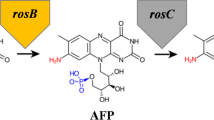Abstract
Flavinogenic yeast overproduce riboflavin (RF) in iron-deprived media. In optimal growth media supplemented with Fe, hexavalent chromium 'Cr (VI)' treatment led to elevated RF synthesis in all cases of 37 flavinogenic strains studied. The level of RF production exceeded the rate observed at iron-deficient conditions. At sublethal Cr concentrations the RF oversynthesis over time correlated well with the growth-inhibitory adaptational period as manifested by the prolonged lag phase. The consecutive logarithmic biomass growth was accompanied by a drop in RF biosynthesis. Cr (VI)-induced RF overproduction was not a result of cellular iron level decrease. The treatment of yeast with Cr (VI) led to the stimulation of GTP-cyclohydrolase and RF-synthase activities, the key enzymes of the RF biosynthesis pathway.
Similar content being viewed by others
References
Arslan P, Beltrame M, Tomasi A. 1987 Intracellular chromium reduction Biochim Biophys Acta 931, 10–15.
Appenroth D, Shulz O, Winnefeld K. 1996 Riboflavin can decrease the nephrotoxic effect of chromate in young and adult rats. Toxicol Lett 87, 47–52.
Appenroth KJ, Bischoff M, Gabrys H, Stockel J, Swartz HM, Walczak T, Winnefield K. 1999 Kinetics of chromium (V) formation and reduction in fronds of the duckweed Spirodela polyrhiza-a low-frequency EPR study. J Inorg Biochem, in press.
Babyak LY, Sibirny AA, Shavlovsky GM. 1993 The selection and some characteristics of mutants Pichia guilliermondii rib81 with defects of riboflavin biosynthesis regulation. Cytologia Genetika 27, 28–31.
Cieslak-Golonka M. 1995 Toxic and mutagenic effects of chromium(VI) A review. Polyhedron 15, 3667–3689.
Corbett GE, Dodge DG, O'Flaherty E, Liang J, Throop L, Finley BL, Kerger BD. 1998 In vitro reduction kinetics of hexavalent chromium in human blood. Environ Res 78, 7–11.
Costa M. 1997 Toxicity and carcinogenicity of Cr(VI) in animal models and humans. Crit RevToxicol 27, 431–440.
Cohen MD, Kargacin B, Klein CB, Costa M. 1993 Mechanisms of chromium cancerogenicity. Crit Rev Toxicol 23, 255–268.
Demain AL. 1972 Riboflavin oversynthesis. Annu Rev Microbiol 26, 369–388.
Dillon CT, Lay PA, Bonin AM, Cholewa M, Legge GJF, Collins TJ, Kostka KL. 1998 Permeability, cytotoxity and genotoxicity of chromium (V) and chromium (VI) complexes in V79 chinese hamster lung cells. Chem Res Toxicol 11, 119–129.
Enari TM. 1955 Effect of cobalt and iron on riboflavin by Candida guilliermondii. Acta Chem Scand 9, 1726–1729.
Fedorovich DV, Kityk IV, Dzala VI, Protchenko OV, Shavlovsky GM. 1997 Accumulation and redox transformations of iron in the yeast Pichia guilliermondii and its flavinogenic mutants. Microbiologia 66, 60–64.
Fedorowicz D, Krzeminska H, Babjak L, Kaszycki P, Koloczek H. 1999a Chromium toxicity in yeast Pichia guiliermondii. Current Genetics 35, 448.
Fedorowicz D, Babiak L, Krzeminska H, Kaszycki P, Kołoczek H. 1999b Stimulation of flavinogenesis by chromium (VI) in chromium-resistant mutants of the yeast Pichia guilliermondii. Folia Histochem Cytobiol 37S 1, 60.
Fedorovich DV, Protchenko OV, Lesuisse E. 1999 Iron uptake by the yeast Pichia guilliermondii. Flavinogenesis and reductive iron assimilation are co-regulated processes. BioMetals 12, 295–300.
Knusel F. 1957 Die Biosynthese des Riboflavins bei Candida guilliermondii (A. Cast) Langeron und guerra und einigen verwandten Arten. Einfluss von Saurenelementen, ins besonders von Eisen und Zink. Arch Microbiol 27, 219–226.
Koh JS, Choin J, Lee JH, Roe JH. 1996 Regulation of the ribA gene encoding GTP cyclohydrolase II by the soxRS locus in Escherichia coli. Mol Gen Genet 251, 591–598.
Lay PA, Levina A. 1998 Activation of molecular oxygen during the reactions of chromium (VI/V/IV) with biological reductants: Implications for chromium-induced genotoxicities. J Am Chem Soc 27, 6704–6714.
Liu KJ, Jiang J, Shi X, Gabry´s H, Walczak T, Swartz HM. 1995 Low-frequency EPR study of chromium (VI) in living plants. Biochem Biophys Res Comm 206, 829–834.
Logvinenko EM, Trach VM, Kashchenko VE, Zakalskij AE, Koltun LV, Shavlovsky GM. 1977 Study of activities of some yeast flavinogenic enzymes in situ. Biochimia 42, 1649–1654.
Lowry OH, Rosebrough NJ, Farr AL, Randall RJ. 1951 Protein measurement with the Folin phenol reagent. J Biol Chem 193, 265–275.
Luo H, Lu Y, Mao Y, Shi X, Dalal NS. 1996 Role of chromium(IV) in the chromium(VI)-related free radical formation, dG hydroxylation, and DNA damage. J Inorg Biochem 64, 25–35.
Naik MS, Das NB. 1964 Effect of cooper and zink deficiency on the synthesis of protein and riboflavin by Aspergillus niger. Indian J Exptl Biol 2, 59–64.
Ramana VV, Sastry KS. 1994 Chromium toxicity in Neurospora crassa. J Inorg Biochem 56, 87–95.
Shavlovsky GM, Logvinenko EM. 1988a Flavin overproduction and its molecular mechanisms in microorganisms. Prikl Biochim Microbiol 24, 435–447.
Shavlovsky GM, Logvinenko EM. 1988b The participation of iron in the regulation of protein synthesis in microorganisms. Uspiechi Mikrobiologii (Adv Microbiol) 22, 108–133.
Shavlovsky GM, Logvinenko EM, Bendorf R, Koltun LV, Shlee D, Reinbothe H. 1980 First reaction of riboflavin biosynthesis-catalysis by a guanosine triphosphate cyclohydrolase from yeast. Arch Microbiol 124, 255–259.
Shukla JP, Prabku KA. 1961 Studies in the production of riboflavin by Aspergillus niger. J Sci Industr Res 20, 40–43.
Sibirny AA, Sharova VP, Kshanovskaja BV, Shavlovsky GM. 1977 Selection of genetic line of the yeast Pichia guilliermondii capable of producing large amounts of spores. Cytologia Genetika 11, 330–333.
Shi X, Dalal NS. 1994 Generation of hydroxyl radical by chromate in biologically relevant systems: role of Cr(V) complexes versus tetraperoxochromate(V) Environ Health Perspect 102, 231–236.
Trach VM, Logvinenko EM, Shlee D, Reinbothe H. 1982 Ein-flus von Transkriptionsinhibitoren auf die Derepression der Riboflavinsynthase in der Hefen Torulopsis candida. Biochem Physiol Pflanzen 177, 585–592.
Wang Y-T, Shen H. 1995 Bacterial reduction of hexavalent chromium Industrial Microbiol 14, 159–163.
Author information
Authors and Affiliations
Rights and permissions
About this article
Cite this article
Fedorovych, D., Kszeminska, H., Babjak, L. et al. Hexavalent chromium stimulation of riboflavin synthesis in flavinogenic yeast. Biometals 14, 23–31 (2001). https://doi.org/10.1023/A:1016643307690
Issue Date:
DOI: https://doi.org/10.1023/A:1016643307690




